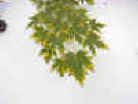|
First I needed to find a subject that looked like
something I could work with. This is not always easy since in nature
you most often need to work with the subjects she provides you and many
of them never seem to come out the way you originally had in mind.
Just keep trying, and learning!
There have been many subjects that I would have liked to study but time,
location and circumstances have prevented it. (Also the best shots seem
to appear when a camera is not available!)
The photo to the right is a subject I found on a crisp October day
last year.
|

|
|
As you can see the camera found a lot more detail in the background than the eye
did. And there is only so much you can do from the top of a ladder
to reframe the shot. This would have been a difficult picture to work
with.
The example at the right solves many post processing problems. In it I
got my wife to hold up a large sheet of white material to serve as a
background. Any color not readily found in the subject would
do, white was handy.
Note: It is wise to find someone who is willing to stand around for long periods
of time in awkward positions or who is also into the photographic process, since wind, light, and
weather are often not on your side and lots of time tends to go by very
quickly.
|

|
|
Using a feature of Adobe Photoshop2.0 that came with my
scanner I made all the white background appear transparent.
(Notice that the gray shadows are different enough to not be included in
the transparent mapping. In other versions I also reduced or
eliminated these gray sections.) At this point I also
cropped the picture to eliminate parts I felt were not in the best interests
of the final output. Some additional color and contrast adjustments
resulted in
the clip shown at the right. The file was then saved in a
".gif" format which retains these transparent properties.
|
 |
|
The image at the top of this page is the clip above, simply placed on
top of a deep red background. I have tried many different colors
as background and each variation results in a slightly different
mood. I believe that last time many of you saw this picture it was
on a deeper purple background with hints of brown in it. This
image gives me a feeling more of spring, even though the leaves are
obviously not spring like.
|
|
Next I started playing around with a new program I'm thinking of
buying called LView-Pro. This work is done with a time limited
test copy. The clip at the right is formed from a
deformation of the clip above called neon edging with an insert of blue
black in the background. The small photo seen here is far more
impressive when expanded and is worth the time it takes to load it.
|

'Leaves In the Heart of Winter'
|
|
Next I added another deformation called a pinch to form the stylistic
block photo shown here.
|

'Through the Glass Block'
|
|
A different deformation called rotating mirrors resulted in this lacy
looking photo after adjusting the parameters to get the final
effect. Once again these last two are far more dramatic when
viewed full screen.
|

'Doily'
|
|
If you would like to try some of this kind of work for yourself I
would be happy to help you in any way I can. The great thing about
digital photography is that you can manipulate images, from any source,
in many different ways and not have to spend a lot to do it.
If you just want to see more of these kinds of images, I may be able
to help you there also. Just let me know.
|